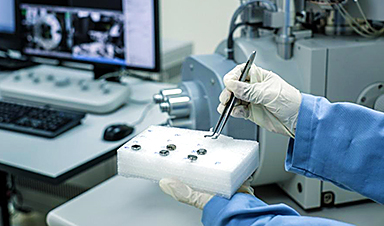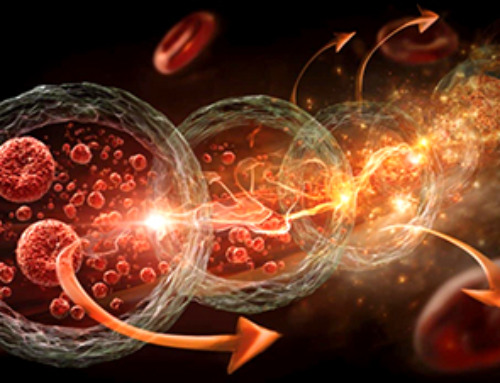Two-dimensional (2D) nanomaterials like graphene have received great research attention for several years, but a new generation of atom-thick materials – MXenes – has recently captured the interest of materials science researchers and nanotechnology developers alike.
Synthesizing MXene Nanomaterials
MXenes are 2D nanomaterials that exhibit high conductivity, high surface area, high functionalization, a site of hydroxide, and many other interesting properties. They were only discovered in 2011, but have been the subject of many studies ever since.
MXenes are inorganic compounds measuring only a few atoms in thickness and are made up of metal carbides, nitrides, or carbonitrides. These materials combine the metallic conductivity of the transition metal carbides with hydrophilic features imparted by their hydroxyl- or oxygen-terminated surfaces.
The first MXene nanomaterial to be reported in 2011 was Ti4N3. Though, this compound is synthesized in a slightly different manner to most of the other MXenes developed since.
Ti4N3 is synthesized by mixing TI4AlN3 with a molten eutectic fluoride salt made up of lithium fluoride, sodium fluoride, and potassium fluoride. This mixture is treated at a high temperature, causing the Al to etch out and yield multilayered Ti4N3.
This material is then delaminated into single layers by immersion in tetrabutylammonium hydroxide and a subsequent sonication step.
Most MXene nanomaterials, however, are synthesized in a top-down (subtractive) selective etching process. This process is scalable without exhibiting any loss or change in the nanomaterials’ properties when batch sizes increase.
The top-down etching process uses strong etching solutions with a fluoride ion such as hydrofluoric acid (HF), ammonium bifluoride (NH4HF2), or a mixture of lithium fluoride (LiF) and hydrochloric acid (HCI).
For example, aqueous HF at room temperature is used to etch the MXene material Ti3AlC2. The HF selectively removes the Al atoms so that the surface of the carbide layers becomes terminated by O or F atoms.
MXene is also sometimes obtained from Lewis acid molten salts like ZnCl2. This method synthesizes a Cl-terminated MXene structurally stable up to 750 °C.
Rapid Progress in MXene Research
So far, 27 MXene materials have been synthesized. These are formed from elements like titanium, zirconium, molybdenum, niobium, tungsten, and hydrogen, along with carbon.
There have been numerous applications for the materials already. Mxenes are employed as conductive layered materials with tunable surface terminations in energy storage applications, both in Li-ion batteries and supercapacitors.
Applications as photocatalytic cells, transparent conducting electrodes, and neural electrodes also capitalize on Mxenes’ unique electrochemical properties.
The nanomaterials can be used in water purification, gas sensing, triboelectric nanogenerators (TENGs), and electrochromic devices.
Key Applications for the Future of Mxene Nanomaterials
The remarkable and unique properties of Mxene nanomaterials have led researchers tackling science’s major challenges to consider how the materials could be useful in their work. As such, Mxene’s have been investigated for use in environmental projects, cleaner energy production, and lifesaving medical technologies.
Environmental Clean Up and Water Sustainability
Mxene’s high surface area, biological compatibility (non-toxicity), robust electrochemistry, and high hydrophilicity make them ideal candidates for advanced environmental clean technologies.
Nanoarchitectures based on Mxene materials can mitigate the role of inorganic pollutants in interfacial chemical transformation and sorption in ecosystems.
They achieve this through three main mechanisms: surface complexation and sorption, catalytic activation and removal, and radical generation-based photocatalytic degradation.
When applied to drinking water sources and water waste, MXene-based filtration systems can have significant impacts on both local communities’ health and wellbeing, as well as the overall health of their surrounding environments.
Electrocatalysts for Hydrogen Energy
According to many forecasters, hydrogen will play a crucial role in transitioning from a fossil-fuel based economy to clean renewable energy. Generating hydrogen with water electrolysis is the preferred solution at present, being the cleanest and most sustainable method.
The development of non-noble metal electrocatalysts is a hot topic of research in hydrogen power. MXene nanomaterials have recently been explored as potential electrocatalysts for hydrogen evolution reaction (HER) electrocatalysis.
The materials display good HER activity and remarkable stability and may help us to break free from fossil fuels.
Biomedical Applications
MXenes may even save lives, as they are currently being explored for numerous biomedical applications. Their non-toxicity and unique properties make them interesting to researchers working on antibacterial safety, advanced medical imaging technologies, biosensing devices, tissue regeneration, and even cancer therapies.
Still, MXenes’ appropriateness and potential for biomedical applications are still not fully understood. As such, many are invested in characterizing the unique nanomaterials. Doing so would aid in understanding their interactions with other materials, especially organic matter, and fully estimating their potential for use in lifesaving medical technology.
News
AI matches doctors in mapping lung tumors for radiation therapy
In radiation therapy, precision can save lives. Oncologists must carefully map the size and location of a tumor before delivering high-dose radiation to destroy cancer cells while sparing healthy tissue. But this process, called [...]
Scientists Finally “See” Key Protein That Controls Inflammation
Researchers used advanced microscopy to uncover important protein structures. For the first time, two important protein structures in the human body are being visualized, thanks in part to cutting-edge technology at the University of [...]
AI tool detects 9 types of dementia from a single brain scan
Mayo Clinic researchers have developed a new artificial intelligence (AI) tool that helps clinicians identify brain activity patterns linked to nine types of dementia, including Alzheimer's disease, using a single, widely available scan—a transformative [...]
Is plastic packaging putting more than just food on your plate?
New research reveals that common food packaging and utensils can shed microscopic plastics into our food, prompting urgent calls for stricter testing and updated regulations to protect public health. Beyond microplastics: The analysis intentionally [...]
Aging Spreads Through the Bloodstream
Summary: New research reveals that aging isn’t just a local cellular process—it can spread throughout the body via the bloodstream. A redox-sensitive protein called ReHMGB1, secreted by senescent cells, was found to trigger aging features [...]
AI and nanomedicine find rare biomarkers for prostrate cancer and atherosclerosis
Imagine a stadium packed with 75,000 fans, all wearing green and white jerseys—except one person in a solid green shirt. Finding that person would be tough. That's how hard it is for scientists to [...]
Are Pesticides Breeding the Next Pandemic? Experts Warn of Fungal Superbugs
Fungicides used in agriculture have been linked to an increase in resistance to antifungal drugs in both humans and animals. Fungal infections are on the rise, and two UC Davis infectious disease experts, Dr. George Thompson [...]
Scientists Crack the 500-Million-Year-Old Code That Controls Your Immune System
A collaborative team from Penn Medicine and Penn Engineering has uncovered the mathematical principles behind a 500-million-year-old protein network that determines whether foreign materials are recognized as friend or foe. How does your body [...]
Team discovers how tiny parts of cells stay organized, new insights for blocking cancer growth
A team of international researchers led by scientists at City of Hope provides the most thorough account yet of an elusive target for cancer treatment. Published in Science Advances, the study suggests a complex signaling [...]
Nanomaterials in Ophthalmology: A Review
Eye diseases are becoming more common. In 2020, over 250 million people had mild vision problems, and 295 million experienced moderate to severe ocular conditions. In response, researchers are turning to nanotechnology and nanomaterials—tools that are transforming [...]
Natural Plant Extract Removes up to 90% of Microplastics From Water
Researchers found that natural polymers derived from okra and fenugreek are highly effective at removing microplastics from water. The same sticky substances that make okra slimy and give fenugreek its gel-like texture could help [...]
Instant coffee may damage your eyes, genetic study finds
A new genetic study shows that just one extra cup of instant coffee a day could significantly increase your risk of developing dry AMD, shedding fresh light on how our daily beverage choices may [...]
Nanoneedle patch offers painless alternative to traditional cancer biopsies
A patch containing tens of millions of microscopic nanoneedles could soon replace traditional biopsies, scientists have found. The patch offers a painless and less invasive alternative for millions of patients worldwide who undergo biopsies [...]
Small antibodies provide broad protection against SARS coronaviruses
Scientists have discovered a unique class of small antibodies that are strongly protective against a wide range of SARS coronaviruses, including SARS-CoV-1 and numerous early and recent SARS-CoV-2 variants. The unique antibodies target an [...]
Controlling This One Molecule Could Halt Alzheimer’s in Its Tracks
New research identifies the immune molecule STING as a driver of brain damage in Alzheimer’s. A new approach to Alzheimer’s disease has led to an exciting discovery that could help stop the devastating cognitive decline [...]
Cyborg tadpoles are helping us learn how brain development starts
How does our brain, which is capable of generating complex thoughts, actions and even self-reflection, grow out of essentially nothing? An experiment in tadpoles, in which an electronic implant was incorporated into a precursor [...]





















